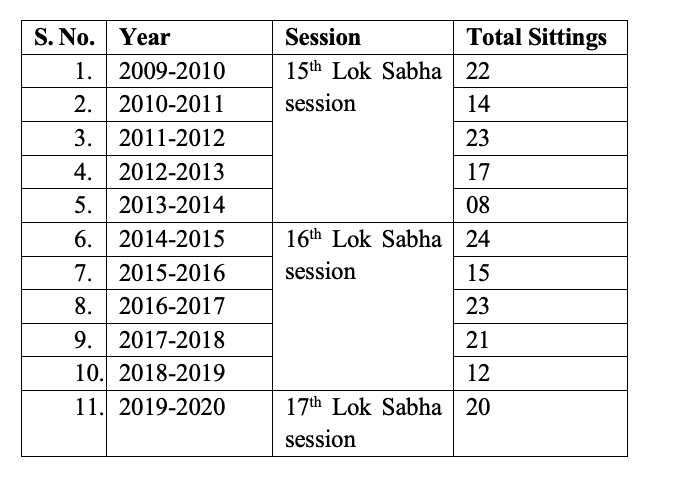This blogpost answers commonly asked questions about the Standing Committee of Information Technology of Parliament of India. Most of these questions apply to all departmentally related standing committees of Parliament of India.
Q. 1 What are parliamentary standing committees?
The Parliament of India has 24 ‘departmentally related standing committees’, also known as standing committees, on different subject areas. These committees are meant to increase the Parliament’s efficiency, in terms of expertise and specialisation in examining their respective subject areas. Each committee exercises jurisdiction over subject matters dealt with by specific ministries/ departments.[1] The Standing Committee on Information Technology (“SCIT”) is one of the current 24 Departmentally Related Committees.
Q. 2 What is the history of the Parliamentary Standing Committee on Information Technology?
The Committee was constituted for the first time on the 08 April 1993 during the 10th Lok Sabha (1991-1996). It was known as the Committee on Communications till 1998-99. It was renamed as Committee on Information Technology in 1999-2000, when the Ministry of Information Technology was also brought under its mandate.
Q. 3 What is the composition of the SCIT? How are members selected for the SCIT?
The SCIT consists of 31 sitting Members of Parliament (“MPs”), with 21 members from the Lok Sabha (Lower House) and 10 members from the Rajya Sabha (Upper House). These members are selected by the respective Speaker and Chairperson of Lok Sabha and Rajya Sabha.[2] The chairperson of the SCIT is appointed by the Speaker of the Lok Sabha. A sitting minister cannot be nominated as a member of the SCIT.[3] The current chairperson of the SCIT is Mr. Shashi Tharoor.
Q. 4 What is the tenure of the SCIT? Can members be re-elected?
The term of the SCIT cannot exceed more than one year, which means that an MP is nominated to the SCIT for one year.[4] This also implies that members cannot be re-elected to the SCIT.
Q. 5 What all issues does the SCIT have jurisdiction over?
The SCIT has jurisdiction over the subject matters that are dealt with by the Ministry of Communications (including the Department of Posts and Department of Telecommunications), Ministry of Electronics and Information Technology and Ministry of Information and Broadcasting[5].
Q. 6 What are the functions of the SCIT?
The SCIT performs the following functions, among others –
a. To consider the Demands for Grants of the relevant ministries/departments; Demands for Grants is the annual expenditure estimate for a ministry, and has to be approved by Parliament
b. Consider legislative bills introduced in either Lok Sabha or Rajya Sabha, subject to such bill being referred to it by either House of the Parliament;
c. Select any subject for examination, based on the Annual Reports of the ministries/departments under its jurisdiction;
d. Consider national long-term policy documents presented to the Parliament, subject to such documents being referred to it by Lok Sabha or Rajya Sabha.[6]
Q. 7 What are the powers of the SCIT?
- The SCIT decides its own agenda, and can examine any issues that it wants to (except for Bills, which are referred to the SCIT by Parliament). The SCIT selects the subjects that it will address during its tenure in its first meeting.[7]
- It can hold study visits to institutions or establishments of ministries under its jurisdiction, with the Speaker’s permission.
- It can appoint Sub-Committees from amongst the committee members to examine the subjects selected by it, and to also scrutinize the action taken by the Government on the observations/recommendations in its report.
- During the course of its deliberations on a given issue, the SCIT may also call for comments from non-governmental sources such as expert third-party organizations or individuals[8].
Q. 8 How often does the SCIT meet? Is there a fixed time period? Where does the committee meet?
The meetings of the SCIT are held on such date and time as fixed by the chairperson.[9] One-third of the committee’s members must be present to have quorum in the meeting.[10] The SCIT has met the following number of times between 2009 and 2019:[11]

Based on the above figures, the SCIT held an average of 18 meetings every year since 2009. The numbers for 2013-14 and 2018-19 are exceptionally less because these were election years.
Q. 9 Does SCIT have the power to take suo motu cognizance of an issue i.e. can it refer an issue to itself?
The SCIT has the power to decide its own agenda, and it can also take up certain matters suo motu for discussing them. For example, the SCIT is currently examining the privacy issues related to the Aarogya Setu app.[12] However, it can consider only such Bills that are referred to it by Parliament. The Committee considers the general principles and clauses of the Bills referred to it and makes Reports thereon within the given time.[13]
Q. 10 Are SCIT reports binding on the government? If not, is there any way in which the SCIT ensures that the government follows its recommendations?
The recommendations in the SCIT’s reports are not binding on the government. The Recommendations of the Committee have persuasive value and are treated as considered advice given by the Committee.[14] However, one way through which the government is accountable for committee recommendations is through ‘Action Taken Reports’ or ATR.
The concerned ministry to whom the SCIT’s recommendations in all reports are addressed has to file ‘action taken replies’ within three months from the date of presenting the report in Parliament.[15] These replies are divided into three categories by the SCIT- (a) recommendations accepted by the government; (b) recommendations which the SCIT does not want to pursue in view of government’s replies; (c) recommendations for which the government’s replies are not accepted by the committee, and which may need to be reiterated, and (d) recommendations for which the government has furnished interim replies.[16]
Based on these replies, the SCIT will draft the ‘Action Taken Report’ and table it in Parliament.
Additionally, the concerned minister will make a statement in the House regarding the status of implementation of the recommendations in the SCIT’s reports. This is done to ensure that the SCIT’s recommendations are taken note of at the highest government level for follow up action.[17]
The recommendations of the SCIT have been previously accepted by the government. For instance, the Information Technology (Amendment) Bill, 2006, was modified by the government based on the recommendations given by the SCIT[18]. It was later enacted as the Information Technology (Amendment)
Act in February 2009[19].
Q. 11 What is the evidentiary value of standing committee reports in Indian courts?
The reports of the SCIT also hold value in terms of acting as an unbiased record of recommendations by a parliamentary committee. The Supreme Court of India has held that a standing committee report can act as an aid for interpretation of a statutory provision. The report can be taken on record by courts as evidence under the Indian Evidence Act, 1872.[20]
Authored by Arpit Gupta, Senior Associate at Ikigai Law. Many thanks to Himanshu Shembekar, a third year student from National Law University, Odisha and Pravi Jain, a third year student from National Law Institute University, Bhopal, for their assistance for this blogpost.
For more on this topic, please reach out to us at contact@ikigailaw.com
[1] Fifth Schedule read with Rule 331C(2) of Rules of Procedure and Conduct of Business in Lok Sabha; Pg. 104, An Introductory Gudie- Departmentally Related Standing Committees, Lok Sabha Secretariat, http://loksabhaph.nic.in/Committee/INTRODUCTORY_GUIDE(ENGLISH).pdf.
[2] Rule 331D(1), Rules of Procedure and Conduct of Business in Lok Sabha.
[3] Rule 331D(2), Rules of Procedure and Conduct of Business in Lok Sabha
[4] Rule 331D(4), Rules of Procedure and Conduct of Business in Lok Sabha..
[5] Pg.1, Standing
Committee on Information Technology, Lok Sabha, available at http://loksabhadocs.nic.in/
LSSCOMMITTEE/Information%20Technology/Introduction/BROCHURE%20OF%20COMMITTEE%20ON%20IT.pdf#page=1&zoom=auto,-21,802.
[6] Introduction to Standing Committee on Information Technology, Lok Sabha, available at http://loksabhadocs.nic.in/LSSCOMMITTEE/Information%20Technology/Introduction/BROCHURE%20OF%20COMMITTEE%20ON%20IT.pdf#page=1&zoom=auto,-21,802.
[7] Para 1.6, Department Related Parliamentary Standing Committee Sections, Sectional Manual of Office Procedure, Rajya Sabha, http://rsintranet.nic.in/intrars/manual/smop_dept_com_sec.pdf
[8] Pg. 114, An Introductory Guide: Departmentally Related Standing Committees, Lok Sabha Secretariat, available at http://loksabhaph.nic.in/Committee/INTRODUCTORY_GUIDE(ENGLISH).pdf.
[9] Rule 264, Rules of Procedure and Conduct of Business in Lok Sabha.
[10] Rule 259, Rules of Procedure and Conduct of Business in Lok Sabha.
[11] These figures have been calculated
[12] Coronavirus | Parliamentary panel on IT starts work on Aarogya Setu, The Hindu, 22 June 2020, https://www.thehindu.com/news/national/coronavirus-parliamentary-panel-on-it-starts-work-on-aarogya-setu/article31891679.ece.
[13] Introduction to Standing Committee on Information Technology, Lok Sabha, available at http://loksabhadocs.nic.in/LSSCOMMITTEE/Information%20Technology/Introduction/BROCHURE%20OF%20COMMITTEE%20ON%20IT.pdf#page=1&zoom=auto,-21,802.
[14] Rule 331N, Rules of Procedure and Conduct of Business in Lok Sabha.
[15] Para 9.1, Chapter 9, Department Related Parliamentary Standing Committee Sections, Sectional Manual of Office Procedure, Rajya Sabha, http://rsintranet.nic.in/intrars/manual/smop_dept_com_sec.pdf.
[16] Pata 9.4, Chapter 9, Department Related Parliamentary Standing Committee Sections, Sectional Manual of Office Procedure, http://rsintranet.nic.in/intrars/manual/smop_dept_com_sec.pdf.
[17] Introduction to Standing Committee on Information Technology, Lok Sabha, available at http://loksabhadocs.nic.in/LSSCOMMITTEE/Information%20Technology/Introduction/BROCHURE%20OF%20COMMITTEE%20ON%20IT.pdf#page=1&zoom=auto,-21,802.
[18] Standing Committee Report on Information Technology (Amendment) Bill, 2006, available at http://164.100.47.193/lsscommittee/Information%20Technology/14_Information%20Technology_50.pdf.
[19] Information Technology (Amendment) Act, 2008, available at http://164.100.47.193/BillsPDFFiles/Notification/2006-96-gaz.pdf.
[20] Sections 57(4) and 74 of the Indian Evidence Act, 1872; see Kalpana Mehta v. Union of India, Writ Petition (Civil) No. 921 of 2013, 09 May 2018, https://main.sci.gov.in/supremecourt/2012/36970/36970_2012_Judgement_09-May-2018.pdf.









